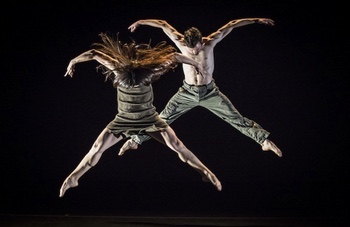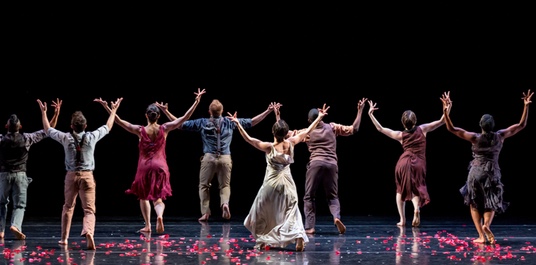Sat 11/12
We went to the Ohio Theatre to see Bodytraffic. The L.A.-based company brought a concert of mixed rep by some hot contemporary choreographers. Each of the three very different dances was well-produced and well-danced. The audience, which filled the theater’s lower levels to capacity, applauded enthusiastically.
One of the choreographers, Victor Quijada, is seen by many as a hometown boy made good. Having grown up B-boying in Los Angeles area barrios, Quijada attended the L.A. County High School for the Arts and went on to dance for Twyla Tharp and Eliot Feld, noted contemporary ballet choreographers. In his choreography for many high-profile dance companies and for his own company, RUBBERBANDance Group, Quijada has asked what seem to be exactly the right questions: “What else could hip-hop be? Could it be sensitive? Could it be communicative?” Unfortunately, we have yet to see any Quijada choreography that successfully answers those questions.
Quijada’s dance for Saturday’s concert, Once Again Before You Go, was a case in point. The curtain went up on a dimly lit stage filled with fog. A single male figure performed slow, understated street dance moves — floor rocks and waving. A lighting change — thin, bright shafts of light across the stage — called attention to the entrance of a second male figure who performed slow capoeira-style handstands and cartwheels. Lighting changes announced other entrances and exits so that as many as four men and one woman occupied the stage for a time.
For a while one female and one male figure interacted around contact-partnering moves in which a hand to the partner’s head or neck initiated a movement, often down to the floor and back up. A very bright flash like a bolt of lightning announced the reentrance of the other three men and the end of the dance. We were taken by surprise by the vociferous applause. Sensitive? Communicative? Was there a story in there? Were we missing something? Call us hopelessly out of touch but for us, other than the title and the lighting, this dance contained neither content nor form, and Quijada’s pertinent questions remain unanswered. Still, we’d rather watch Quijada ask his questions and fail trying than watch many other choreographers succeed.
Like Quijada, Richard Siegal choreographs for many high-level dance companies and is the recipient of many awards. In addition to freelancing, he has his own base of operations, the Bakery, “an interdisciplinary platform for research and production of visual media, dance and performance.”
Unlike Quijada, Siegal has apparently given himself and the Bodytraffic dancers a simple, straightforward assignment for o2Joy: to have a blast dancing to jazz standards. Fast, brightly lit and cheerful, o2Joy is the perfect crowd-pleasing dance to end a concert. After a male solo to an Oscar Peterson instrumental and a female solo (which turns into a trio) to Billie Holiday’s On the Sunny Side of the Street, Siegal brings us Ella Fitzgerald’s All of Me with one of the male dancers, in a somewhat gender-bending role, convincingly lip synching.
Even aside from the amusing gender-bending, All of Me is our favorite number in o2Joy. Too often in other numbers in o2Joy, Siegal reverts to big jumps — almost always, in our opinion, a lazy and inappropriate choreographic response to jazz music — but in All of Me the steps are more often into the floor and unafraid of repetitive patterns.
Choreographer Barak Marshall and his dance, And at midnight, the green bride floated through the village square…, require some historical context. In 1949 and 1950 the new nation of Israel airlifted thousands of Arabic-speaking Jews — including nearly all the Jews in Yemen — to Israel. Among them was a 12-year-old girl named Margalit Oved who became an acclaimed dancer, singer, choreographer and the mother of Barak Marshall. It was she who told young Barak the supposedly true story about her Yemenite neighbors on which green bride is based.
Put aside, dear reader, what you learned about Jewish wedding customs and gender relations from Fiddler on the Roof. Green bride concerns Yemenite Jews — the Mizrahim — as seen through Marshall’s sharply critical, satiric eye. Yemenite women, Marshall seems to say, have no good options. Green bride shows us this through a series of short, formulaic scenes or motifs, many of which recur with minor variations.
The first thing we see in green bride is a worried, solitary female with a bell tolling ominously in the background. This motif repeats three times in green bride. Another recurrent motif features fast and frantic group dances, mostly unison hand gestures punctuated by folk dance steps. All eight dancers. All four women. All four men. And at the very end, all eight dancers again.
For another scene that recurs three times with minor variations, a man and a woman stand at a microphone. He says, “You take a fish (… a pigeon… a lamb)….” The woman protests that said animal is meant to live free but the man rejects this out of hand saying that it is “a stupid animal that deserves to be eaten.” He then describes a recipe full of very thinly disguised erotic metaphor. It works.
Six more varied scenes are sprinkled throughout green bride. In one we see a man reading a newspaper on a bench. The four women wait in a line. The waiting room bell dings and the first woman sits beside the man and strews flower petals. He does not react, the bell dings again, and that woman is lifted up by the other three men and put aside on her back with her legs in the air. The same pattern is repeated with slight variations until all four women are lying in a neat, ignominious row.
In another of the six scenes we hear lambs bleating. As the lights come up the four women are variously carried and dragged in, their hands and feet tied like so many lambs to slaughter. For the final scene, enter the bride amid ululation.
Here follows a surreal fantasy in which the bride shoots the four men and they fall in a spray of flower petals. Is this a reference to orgasm as a little death? More likely a Yemeni woman’s plan for happiness, first-kill-all-the-men. Wry laughs from the women in the audience.
A final, fast and frantic group dance, and it’s over. Yemeni gender relations ruthlessly and hilariously skewered in 29 minutes. Thanks, DanceCleveland, for another enjoyable, wonderful concert!

Next for DanceCleveland, Dance Theatre of Harlem with two shows on Sat 1/21/17.
[Written by Elsa Johnson and Victor Lucas]
